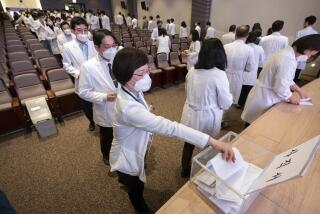In Near Future, More Doctors May Make Fewer Dollars
- Share via
Though the public may not realize it, doctors are being caught increasingly in a squeeze that may, by 1990 or the turn of the century, radically alter the way medicine is practiced and the manner in which physicians are accustomed to living.
Economists and social science experts prominent in the arcane field of health care public policy have already made quite a lucrative sideline of trying to fathom the physician crystal ball, a process that has had mixed results and yielded often contradictory predictions.
Among the most prominent of these experts is Columbia University economist Eli Ginzberg, who, in a medical journal editorial to be published today, makes nine specific predictions of what the future holds for doctors and their patients. Ginzberg has a history of accurately forecasting trends in the supply of physicians and its implications for health care consumers.
As early as 1965, Ginzberg contravened what was then the national perception of an emergency posed by a shortage of physicians, predicting that policy steps being taken then would produce a harmful glut of doctors. Many prominent study commissions and experts inquiring into the situation in the last five years have conceded that the glut prediction has come true.
Wrote Book on Subject
And while Ginzberg--who published a book aimed at a professional audience on the same general subject last year--concedes that his accuracy this time may not be total, he says he is convinced that “some of them, although surely not all, will turn out to be correct.” Among Ginzberg’s predictions are these:
--Though a government commission recommended in 1980 that drastic steps be taken to stem the oversupply of doctors--which, it is often argued, drives up the cost of health care without adding to its quality--the number of doctors in the United States will continue to go up in the foreseeable future. That will result, for “certain,” in individual physician incomes dropping, “probably appreciably.” The irony in this is that the 1980 warnings, if they had been heeded, could have forestalled much of the disruption. But at all levels of government, and within the profession, asserted Ginzberg--who was not a member of the commission--progress has been “excruciatingly slow.”
Fewer Hospital Admissions
--The United States has probably reached the absolute limit in terms of use of hospitalizations, as questionable admissions are eliminated and procedures done on an outpatient basis are substituted for those that now require an overnight stay. With fewer people admitted, the hospital system will continue to follow a quickening trend toward merger of many facilities and growing influence of entrepreneurial, for-profit concerns whose motives have been widely questioned. Many hospitals will be turned into nursing homes. Many others will be driven out of business by a lack of patients.
--Doctors’ appointment books will become ever more scantily booked. The number of visits to doctors per capita will continue to decline. At the same time, with young physicians emerging from medical school saddled with ever-increasing debts in the form of loans, they will face staggering costs when they attempt to get into practice. The result will be that young doctors will be drawn increasingly into health maintenance organizations and other group practice situations, bringing about a trend toward disappearance of the traditional doctor’s office.
--With more and more competition for an ever-more constrained number of dollars spent on health care services, doctors will increasingly find themselves competing with hospitals--institutions with which physicians have traditionally been the closest of allies. In such business enterprises as outpatient surgery, doctors and hospitals will be locked in competition for the same patients, as doctors’ offices and hospitals, increasingly, offer the same services. Competition will occur in ways not yet even anticipated.
Ginzberg’s predictions are being published in the Journal of the American Medical Assn., where they will almost certainly provoke still more debate among doctors in a controversy that was already raging.
Physicians Shaken
Ginzberg said he wrote the editorial, for the AMA’s most widely circulated journal, because he was struck by the extent to which both young and older physicians seem shaken by what they perceive as major changes in their profession, occurring right before their eyes, largely outside their control.
In a telephone interview from Puerto Rico, where he was doing some consulting work, Ginzberg agreed that the net result of the drastic change now taking place will quite likely be destruction of the traditional image of the American doctor. Though some experts have argued that the image has been largely a myth, anyway, the physician has been seen as a rugged individualist, waging a solo war against disease and discomfort, enjoying status as almost a priestlike figure.
“I think the whole gloss is off medicine,” Ginzberg said. “The younger people will have to fight their way into a system that is increasingly constrained. A lot of them are coming out with $80,000 in debt. That translates to $1,000 a month, just to repay medical school loans, in the first years of a practice.
‘Still Make a Living’
“Physicians will still make a living in the U.S.--and a pretty good living--but they will not have a very attractive profession anymore. Incomes are going to go slowly and steadily down. It will be particularly tough for young doctors.
“Many of them will have to practice in a rather unattractive environment. They will become mass producers, and they will have to follow protocols (instead of their own individual judgment).”
The Ginzberg editorial is just the latest of a series of publications in both professional journals and other forums documenting the change to which medicine is being subjected. Much of the current debate in the profession had its impetus with publication of the report of the Graduate Medical Education Advisory Committee, established by the U.S. Department of Health and Human Services to try to predict the future of medicine and medical manpower and cope with unavoidable change.
Five years ago, the commission recommended strict regulation of the number of doctors being trained as well as a virtual halt to the admission to practice in the United States of physicians trained in other countries. Few of the recommendations have been acted upon but that has not quieted the controversy.
Working Fewer Hours
In the American Journal of Public Health last year, for instance, two AMA economists, working with survey data collected annually by the association from its members, concluded that doctors on the average were working 3% fewer hours per week in their office-based practices than a decade earlier. The study also predicted that, as group practices like HMOs and other forms of corporate and for-profit health care proliferate, doctors in traditional private practices are likely to find themselves more and more idle.
In another prominent journal, Annals of Internal Medicine, last year, a study team headed by the president of the renowned Robert Wood Johnson Foundation--which has also underwritten some of Ginzberg’s research--predicted that changes in the health care system are likely to drastically reshape the nation’s teaching hospitals, where young interns and residents are prepared for future practice.
The study by Dr. David Rogers concluded--and Ginzberg agreed--that a long-time alliance between the federal government and teaching medical centers, in which the government has channeled billions of dollars into training doctors, increasing their numbers and improving their quality is “unraveling,” largely because the medical profession at large has failed to take note of clearly developing trends toward larger numbers of physicians in more and more specialties, with a corresponding squeeze on general care medicine.
Other observers have contended that there may be hidden advantages in what has happened. Four Rand Corp. researchers, for instance, concluded in 1982 that the growing glut of physicians was clearly forcing doctors to populate small and medium-size cities and towns that had previously been unappealing to physicians. But others noted that doctors forced by economic circumstance to practice in places they dislike are not likely to be as well motivated as their colleagues who don’t feel similarly trapped.
Not Everyone’s Pessimistic
To be sure, not all observers are as pessimistic as Ginzberg. One of them, Dr. William B. Schwartz, a Tufts University professor and consultant to both Rand and the Brookings Institution, a prominent Washington think tank, even believes that the glut of doctors expected to reach its most disruptive levels by about 1990 may not materialize after all.
Ginzberg took note of this possibility, but he warned that if the glut is absorbed, it will be because doctors have simply found largely superfluous ways of artificially keeping themselves occupied.
And Schwartz agreed that what is happening today will surely bring about major change in medicine. “I think there are going to be many fewer hospitalizations for cases that probably shouldn’t have been hospitalized in the first place,” Schwartz said. But he said that today’s attempts to make health care more economical will reach the limit of their effectiveness in a few years, “once we squeeze the inefficiencies out of the system.”
When that point is reached, Schwartz predicted in a telephone interview from Boston, “we are still going to have a rapidly aging population and an enormous rate of technological change. I can’t predict what will happen with any confidence, but what we’re doing now is the easy stuff. We’re getting rid of useless tests and hospital stays, but that’s not the long-term problem or the critical question.”
Crisis a Few Years Off
Schwartz said he believes that the crisis moment for medicine, in which American society must reach a series of crucial decisions on what kind of health care system it will have, who will be given expensive types of care and how doctors will be regulated and employed, is at least four or five years away--possibly more.
What has happened in the interim, Schwartz said, is that while the debate on the future of health care has been raging within medicine, there has been a curious quiet on the subject among the public at large. “I must confess that I don’t hear a great deal of discussion about this among those who are not primarily concerned with the field.”
Schwartz said that there may be something approaching a public policy time bomb ticking, nonetheless. Ironically, he said, public opinion may have been stifled, he contended, by one of the very side effects of the impending crisis--the influx of doctors into communities that had previously not enjoyed adequate access to health care.
The presence of doctors in places where they had not practiced before has quieted a public outcry of the 1960s and 1970s, Schwartz said, even though 30 million Americans still don’t have any form of health insurance--government or private--and are effectively placed outside of the existing health care system.
But the lull, Schwartz said, is only serving to postpone a decision that will be difficult when it must be made--no matter when that is. It will be a question influenced by a variety of factors, of which doctor availability is just one. It will center on whether the United States, as a nation, is willing to pay the economic costs of maintaining the number of physicians it will have--and their arsenal of technological methods of treating disease--by 1990 or the year 2000, or whether the cost will be perceived as too great and a system of rationing of care and regulation of death and survival is put into place.
Said Schwartz: “That choice will be, ‘Do we really exploit technology to its fullest or do we call a halt at that point and begin denying care and rationing it?’ ”






